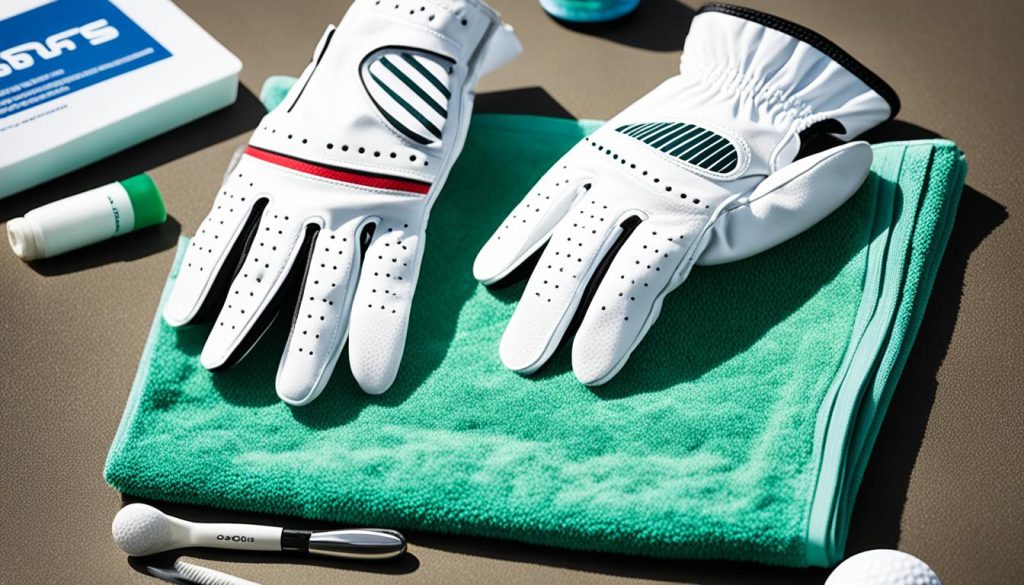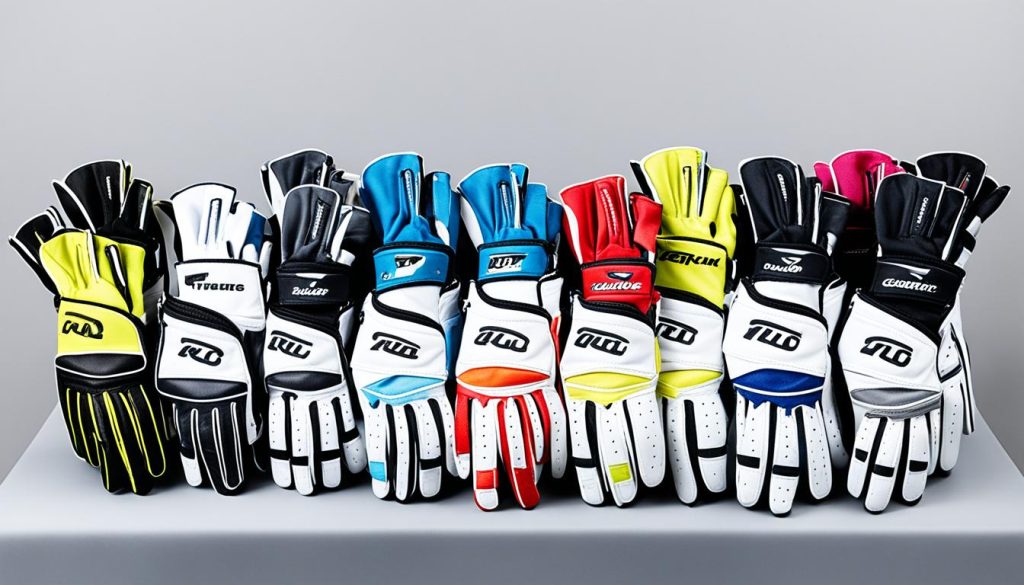Imagine this: You’re on the golf course, the sun shining down on the lush green fairways, and you’re about to take your swing. As you grip the club, you feel the comfort and support of your golf glove, a trusty companion throughout your rounds. But have you ever wondered how long this essential piece of equipment will last?
When it comes to women’s golf gloves, their lifespan can vary depending on a range of factors. From the quality of the glove and the frequency of use to the grip pressure and exposure to wet conditions, these gloves go through a lot to ensure your game is on point.
That’s why understanding the lifespan of your golf glove is crucial for optimal performance and comfort. Just like any other piece of sports equipment, golf gloves wear out over time. The leather may become less tacky, offering reduced grip, or signs of wear like cracks may start to appear. When you notice these signs, it’s time to consider replacing your glove.
But how long can you expect your women’s golf glove to last? The answer is not always straightforward. Some golfers may find themselves needing to replace their gloves every few months due to heavy use, while others may be able to prolong the lifespan of their glove for a more extended period. It all depends on your individual playing style, frequency of use, and how well you care for your glove.
In this article, we will delve into the factors that contribute to the wear and tear of golf gloves, the benefits of wearing them, and tips for maximizing their lifespan. Whether you’re a casual golfer or a passionate enthusiast, stay tuned as we explore the world of women’s golf gloves and how they can enhance your game.
Key Takeaways
- The lifespan of women’s golf gloves can vary depending on factors such as quality, grip pressure, and exposure to wet conditions.
- Signs that indicate the need for a new glove include wear and tear, decreased grip performance, and visible cracks or holes.
- Proper care and maintenance can help prolong the lifespan of your golf glove, such as avoiding wet conditions and cleaning them regularly.
- Choosing the right golf glove, made with premium materials like cabretta leather, can enhance durability and grip.
- Regularly inspecting your golf glove and replacing it when signs of wear become apparent will ensure optimal performance on the golf course.
Benefits of wearing a golf glove
Wearing a golf glove provides numerous benefits for women golfers. Not only does it enhance your grip on the club, but it also improves your swing and decreases grip pressure, leading to better performance on the golf course.
Improved Grip
One of the primary advantages of wearing a golf glove is the enhanced grip it provides. When made with premium cabretta leather, a golf glove offers a tacky texture that prevents your hand from slipping during swings. This improved grip helps you maintain control of the club and execute your shots with precision. It gives you the confidence to swing freely, knowing that the club won’t slip out of your hand.
Decreased Grip Pressure
A golf glove allows for a looser grip on the club, which can significantly reduce grip pressure. When you grip the club too tightly, it can negatively impact your swing mechanics and performance. By wearing a glove, you distribute the frictional force evenly across your entire hand, easing strain on your fingers and reducing the likelihood of blisters or skin irritation.
Better Swing Mechanics
By providing a secure grip and reducing grip pressure, a golf glove promotes better swing mechanics. With a relaxed grip, you can achieve a smoother and more fluid swing, resulting in improved accuracy and distance. The glove acts as a buffer, absorbing excess pressure and allowing your hands to move more freely throughout the swing.
Enhanced Comfort and Protection
Aside from improving grip and swing mechanics, a golf glove offers added comfort and protection. It creates a barrier between your hand and the club, minimizing the risk of blisters and reducing friction-related discomfort. The glove also protects your skin from the rough texture of the club handle, ensuring a more enjoyable and pain-free golfing experience.
Overall, wearing a golf glove is essential for any woman golfer looking to optimize her performance on the course. Its benefits, including improved grip, decreased grip pressure, and enhanced comfort, make it a valuable accessory that can positively impact your game.
Factors that contribute to glove wear
Golf gloves wear out due to various factors that contribute to their deterioration over time. Understanding these factors can help you take steps to prevent excessive wear and maximize the lifespan of your golf glove.
Friction and Improper Grip
The way you hold the golf club can significantly impact the wear on your glove. Holding the club too much in the palm of your hand can cause the club to slide around, creating increased friction with the glove. This friction wears out the glove faster and affects its overall effectiveness. To minimize wear, ensure you have a proper grip, with your fingers securely wrapped around the club, allowing for a comfortable and controlled swing.
Swing Mechanics
The mechanics of your swing can also contribute to glove wear. Toe and heel mishits, where the club strikes the ball at an angle instead of the sweet spot, can result in slight twisting of the hands. This twisting motion increases the friction between the glove and the club, leading to faster wear. Practicing and refining your swing mechanics can help reduce unnecessary friction and prolong the lifespan of your glove.
Worn-out Grips
The condition of your golf club grips can also affect the wear on your glove. Worn-out grips create a more rigid surface, increasing the friction between the club and the glove. This excessive friction accelerates the wear on the glove. Regularly inspect your grips and replace them when necessary to maintain a smooth and consistent surface that reduces friction and prolongs the life of your glove.
By being mindful of the factors that contribute to glove wear, such as friction, improper grip, swing mechanics, and worn-out grips, you can take proactive measures to ensure the longevity of your golf glove. Now let’s explore the signs that indicate the need for a new golf glove.
Signs that indicate the need for a new golf glove
When it comes to your golf glove, keeping an eye out for signs of wear and tear is essential for maintaining optimal performance on the golf course. Over time, the constant grip pressure and exposure to different weather conditions can take a toll on your glove, leading to decreased performance. Here are some signs that indicate it’s time to replace your golf glove:
- Visible wear and tear: Holes, significant wear on the heel or thumb pad, or worn-out stitching are clear signs that your glove is no longer providing the necessary grip and protection.
- Decreased performance: As your golf glove deteriorates, its ability to provide a secure grip decreases. This can lead to issues with your swing mechanics, impacting your accuracy and distance off the tee. Even a small amount of wear can have a noticeable impact on your game.
Don’t underestimate the importance of a well-functioning golf glove. It plays a crucial role in enhancing your grip and increasing your confidence on the golf course. As soon as you notice any of these signs of wear and tear, it’s time to invest in a new glove to ensure you maintain the highest level of performance.
Remember, your golf glove is a crucial piece of equipment that directly affects your game. By recognizing these signs and replacing your glove when needed, you can ensure that your grip remains secure and your performance is not compromised.
Tips for prolonging the lifespan of your golf gloves

Proper care and maintenance are essential for maximizing the lifespan of your golf gloves. By following these tips, you can extend the durability of your gloves and get the most out of them.
1. Avoid exposing your gloves to wet or rainy conditions: Moisture can significantly reduce the lifespan of your gloves and affect their fit and grip. Always keep your gloves dry and protected from rain or wet grass.
2. Avoid excessive sweat accumulation: Excessive sweat can cause the gloves to shrink over time. To prevent this, wipe your hands regularly during play and consider using moisture-wicking wristbands or powder.
3. Regularly clean your gloves: Dirt and debris can affect the quality and performance of your gloves. Clean them after each use using mild soap and water. Gently hand wash them, rinse thoroughly, and let them air dry in a well-ventilated area.
4. Store your gloves properly: Proper storage can help extend the durability of your gloves. Avoid leaving them in extreme temperatures or direct sunlight, as these conditions can damage the material. Instead, store them in a cool, dry place, ideally in a ventilation bag or in an airtight container with moisture-absorbing packets.
By following these glove care tips, you can extend the lifespan of your golf gloves and maximize their durability. Taking care of your gloves not only saves you money but also ensures a comfortable and effective grip for improved performance on the golf course.
Choosing the right golf glove for optimal lifespan

When it comes to selecting a golf glove, your choice can have a significant impact on its lifespan. Factors such as material composition and fit can determine how long your glove will last and how well it performs on the course. To make the right selection, consider the following:
Glove Selection: Leather vs. Synthetic
The choice between leather and synthetic gloves is a crucial decision that can affect both grip and durability. Premium golf gloves made with a higher composition of leather, like the Bender Golf Cabretta leather gloves, generally offer a superior grip and longer lifespan compared to gloves made primarily of synthetic fabrics.
Leather gloves tend to be more breathable and provide a natural feel, allowing for better control and sensitivity during swings. The leather material also molds to your hand over time, creating a personalized fit. Synthetic gloves, on the other hand, often provide better moisture-wicking capabilities and are generally more affordable.
Finding the Perfect Fit
Finding a golf glove that fits your hand perfectly is essential for optimal performance and longevity. Different glove brands and designs may offer varying fitments, so it’s important to try on various options before making a decision. Some golf facilities even have glove fitting gauges to help you find the right size.
A well-fitting glove should be snug but not uncomfortably tight. It should cover your entire hand and reach just below your wrist. The fingers should have a slight bend to them, ensuring a secure grip without restricting movement.
Remember, a glove that fits properly will minimize friction between your hand and the glove, reducing wear and tear and extending its lifespan.
Consider the table below to compare the pros and cons of leather and synthetic golf gloves:
| Leather Golf Gloves | Synthetic Golf Gloves |
|---|---|
| Better grip and feel | Moisture-wicking properties |
| Longer durability | Generally more affordable |
| Molds to your hand for a personalized fit | Less breathable |
Remember, selecting the right golf glove is a personal choice that depends on your preferences and playing conditions. By considering factors like material composition and fit, you can find a glove that not only enhances your performance but also prolongs its lifespan.
Conclusion
When it comes to the lifespan of women’s golf gloves, there are several factors to consider. The frequency of use and grip pressure play a significant role in determining how long a glove will last. By monitoring the wear and tear of your golf glove, you can ensure optimal performance and comfort on the golf course.
To optimize the lifespan of your golf gloves, it is important to follow proper care and maintenance techniques. Regularly inspecting your gloves for signs of wear, such as holes or significant wear on the heel or thumb pad, is essential. When these signs become apparent, it is time to replace your glove to maintain a consistent grip and enhance your overall performance.
Additionally, taking proactive measures to extend the lifespan of your golf glove is crucial. Avoid exposing your gloves to wet or rainy conditions and excessive sweat accumulation, as these can significantly reduce their durability and affect their fit and grip. Properly cleaning and storing your gloves, away from extreme temperatures and direct sunlight, can help maximize their longevity.
By optimizing the lifespan of your women’s golf gloves and replacing them at the right time, you can ensure a reliable and effective grip that enhances your performance on the golf course. Remember to choose a glove that fits your hand perfectly and is made with high-quality materials, such as the premium golf gloves offered by Bender Golf. With proper care and replacement timing, you can enjoy long-lasting and high-performing golf gloves that support your game.

